I’m trying a new platform to share stories about cycling and walking. Some of it is science, some of it is personal and none of it is sedentary. I hope it moves you.
It’s here.
Hope to see you there. Hope you like it.
I’m trying a new platform to share stories about cycling and walking. Some of it is science, some of it is personal and none of it is sedentary. I hope it moves you.
It’s here.
Hope to see you there. Hope you like it.
Hmmm. It’s more than three years since my last post. If you’ve been waiting on tenterhooks and checking back every day then I admire your patience but, honestly, you should seek help.
However, if you’ve been busy like me with other things, please don’t worry that I’m going to keep you here for very long. It’s just to say that during the intervening 40 months, cycling hasn’t stopped nor has science and, consequently, neither have I.
I gave a few talks, chaired the odd conference, wrote a lot of magazine and website articles, sat back in awe as publishers in several countries translated and published new language versions of my book and led some very popular cycling science rides with my mate Derek for the national science festival.
And I’ve been tweeting like there’s no tomorrow (which is always a worrying possibility). Oh, and I revised the UK version of my book and it’s now out in paperback.
I said I wouldn’t keep you for long this time. Hope to see you before another three years pass by. Until then, buy my book, read my articles and wave to me as I pedal past on my way to another laboratory.
It’s been a while since I posted anything so I’d like to thank all of my readers, both of them, for being so patient. The reason for the hiatus is that I’ve been writing for a host of magazines, instead.
The magazine list includes, in alphabetical order, Alphr, Bicycling, Bikes Etc, Cycle Sport, Cycling Active, Cycling Weekly, Cyclist and mbr.
If you want to check them out, some of the stories are online. For example, you can see my recent story for Bicycling here.
My contributions to Bikes Etc and Cyclist are online here and there may be more in a few weeks so keep checking back.
And there are a lot of shorter pieces of mine on Cycling Weekly’s website here.
You can read some of my bike-related articles on Alphr here.
The other magazines are not published freely online, although subscribers can download digital versions.
Top tip: Some public libraries in the UK also make digital versions of cycling magazines available to their members for download for free!
I’m still tweeting like crazy about any and every science paper that is related to cycling. I haven’t gone away. I won’t go away. There’s just so much going on that it’s hard to keep up.
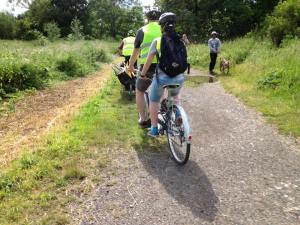 Still learning. That’s my lesson from the Cycling Science tour in Oxford on the longest day of the year. Even though I’d led it a few times before in other cities and thought I knew it all, I came away knowing even more.
Still learning. That’s my lesson from the Cycling Science tour in Oxford on the longest day of the year. Even though I’d led it a few times before in other cities and thought I knew it all, I came away knowing even more.
It may have been the lovely bunch of riders who came along – all ages, all genders, all kinds of bikes. It may have been the lovely route plotted by Science Oxford. It may have been the lovely weather.
Whatever the trigger, there was a moment on the tour when I gained a little bit more understanding about how best to demonstrate some of the science that makes cycling magic. So it’s not just the lovely riders who discover stuff, en route, from the demonstrations and experiments.
Of course, having written a book about Cycling Science, I’d cockily thought there was nothing else to learn.
To write it, I’d read hundreds of thousands of words from hundreds of papers and synthesised them into 192 lovingly illustrated pages.
Yet, to really understand bicycles and the science that makes cycling work, you’ve got to get hands-on, feet on and, yes, bum on, too.
So it was that, during one of the demonstrations, I had a small epiphany.
All the demos and experiments had pretty much worked at each stop on our way to Aston’s Eyot. Then, nervously, I tried to show how the lowest spoke in a wheel gets slacker and carries less load than the other spokes.
I was worried because it hadn’t worked very well on some of the other tours I’d led.
But, in that verdant glade not far from the city centre, on a blazing afternoon on the longest day of the year, it worked perfectly. I became midsummer merry.
The lesson for me was when I realised why it had worked. Unwittingly, I’d used a wheel with spokes laced radially. Prevously I’d always used the more common type, with tangential spokes.
The difference it made to the lovely bunch of riders may have been small. The difference it made to me was enormous. A key point about wire-tensioned wheels had been made clearly and I had learned something new – to always use a radial wheel for that particular demonstration.
To describe the demonstration in detail here would be to spoil the surprise for future Cycling Science tourers. And really, it is an adventure that has to be hands-on, feet on, and, yes, bum on, too.
Naturally I’ll be very happy to bring the new improved resoundingly fantastic demonstration with the radial wheel and the entire tour to everyone who wants it. Drop me a line to book your tour.
And, when that happens, which I hope will be soon, I look forward to learning yet more from the whole experience.
Photos courtesy of Science Oxford
Follow Cycling Science on Twitter
What did I know of Oxford before my visit last Friday? I wore a dubious pair of Oxford bags in the ’80s and that was the sum of it. Now I know a bit more and it’s a revelation.
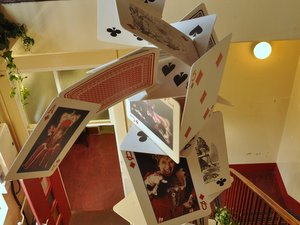 First, there’s The Story Museum. Why aren’t all libraries and museums like this, including those aimed at grown-ups? These beautifully-designed rooms will spur you to read any book, immediately.
First, there’s The Story Museum. Why aren’t all libraries and museums like this, including those aimed at grown-ups? These beautifully-designed rooms will spur you to read any book, immediately.
As it is, the next Cycling Science presentation will be held there at 6.30pm on Sunday 21 June. I’m privileged to share the bill with Dr Tom Cohen, deputy director of the Transport Institute at UCL.

Tom will give an evidence-based presentation about danger, risk, responsibility and, er, helmets. Yes, helmets. So expect a lot of fireworks. I might have to hide under the giant bed in the room upstairs.
I’m planning to include brand new information about a recently-discovered material that could have as big an impact on bicycles in the 21st century as carbon fibre did in the 20th and steel did in the 19th.
You’ll have to come to the talk to find out if you’ve guessed correctly.
There will also be a couple of Cycling Science Rides during the day. I’m indebted to Tara at Science Oxford for showing me the paths and tracks past the river and through meadows of this surprising city.
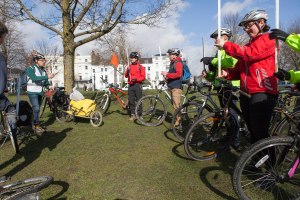 Compared to previous Cycling Science rides, these will be positively rural, despite being in the centre of a conurbation. Tara’s picked out a great route and, as ever, they will be family-friendly.
Compared to previous Cycling Science rides, these will be positively rural, despite being in the centre of a conurbation. Tara’s picked out a great route and, as ever, they will be family-friendly.
If you think you know HOW a bicycle works, these rides, complete with demonstrations and experiments, will show you WHY a bicycle works. We even dreamed up a couple of new stunts to open your eyes to the magic that is cycling.
There will also be an opportunity to purchase signed, discounted copies of Cycling Science, my book which has grown into live talks, led rides and helped me to discover Oxford.
I hope to see you there.
If you’ve not heard of the Faculty of Science and Engineering at the University of Chester, you have now. It’s new, fast-moving and extremely welcoming.
What’s it got to do with cycling science? Well, the powers that be at the Faculty have their fingers on the pulse and recognise that cycling is blossoming.
So they invited me to lead a cycling science ride at the weekend, an initiative generously supported by CWAC/iTravel.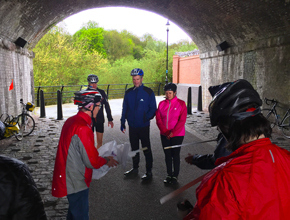
That’s why a group of people could be found in a back lane near the River Dee, discussing the functions, materials and dimensions of that most under-rated component, the spoke.
Tangential, radial, three-cross, four-cross, bladed, steel, aluminium, carbon – all the little niceties were discussed vigorously.
One of the cyclists realised for the first time that the front wheel he’d been using for more than a year has lovely radial spokes – and why his rear wheel doesn’t.
To cap it all, another rider, an information systems expert of course, had a tuning app on her smartphone so we could demonstrate to any doubters that it’s the tension in the wire spoke that keeps the wheel together.
The weight of a general practitioner, who volunteered innocently, bearing down on the axle was then shown to be enough to reduce the frequency of the lowermost spoke by half a tone.
Elsewhere on the ride, along Chester’s glorious Greenway, the effects of rolling resistance were demonstrated by putting some air in the tyres on which an esteemed chemical engineer usually rides almost totally flat.
Human balance, steering, the self-stable dynamics of a bicycle, aerodynamics and how to hover simply by pedalling hard (and building an enormous lightweight helicopter) were all covered.
So, if you’re looking to study science or engineering, you could do worse than to consider Chester University. Not only do they know HOW a bicycle works, they also know WHY.
Photos: Garfield Southall
I’ve got my work cut out this month, preparing for several gigs at Edinburgh International Science Festival and Chester University.
None of them will be quite the same as each other or the same as what’s gone before.
Among the line-up in Edinburgh at 5.30pm on Sunday 12th April will be Scottish national junior women’s road race champion Ashleigh Fraser.
She’s going to explain the science of nutrition – what to eat to be an elite cyclist. It’ll tell me where I went wrong because I suspect my teenage diet of apple pies and Cheesey Wotsits weren’t much good.
And Professor Andrea Sella will be going further than Ernesto Colnago ever dared. If Eddie Merckx had come to a Cycling Science presentation before his 1972 attempt on the world hour record, he would’ve done even better. Andrea’s demonstration is a real eye-opener and UCI rule-makers should start taking notice so they can close another loophole…
I’m refining the aerodynamics demonstrations and showing some mildly embarrassing home movie from last century, together with some futuristic stuff. A tenuous link between Edinburgh Castle and the science of cycling will also be fully exploited without apology or shame.
The gigs for Chester are going to be full on and part of the University’s excellent efforts to boost cycling in the city. I used to live nearby and spend my weekends there so it’s great to be going back
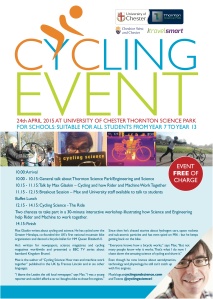 The first day, Friday 24th April, will be for students from year 7 to university level. I’ll be giving a cycling science presentation, with a few demonstrations thrown in, and then leading two short cycling science rides around the Thornton campus.
The first day, Friday 24th April, will be for students from year 7 to university level. I’ll be giving a cycling science presentation, with a few demonstrations thrown in, and then leading two short cycling science rides around the Thornton campus.
On the second day, Saturday 25th April, the University and others will be running several events in the city centre. I’ll lead a FREE public ride about cycling and science from the university’s city campus in the afternoon. Come along and take part in the experiments and demonstrations to learn about WHY cycling actually works.
In the evening I’ll be giving a presentation about what was probably the first mountain  bike crossing of the Greater Himalaya. I can’t believe I actually did it so do come along and learn about the ridiculous risks I took as a fool-hardy and unprepared younger self.
bike crossing of the Greater Himalaya. I can’t believe I actually did it so do come along and learn about the ridiculous risks I took as a fool-hardy and unprepared younger self.
The Chester events are FREE. Book your tickets for the Saturday afternoon ride here. For the Himalayan adventure presentation, book your free tickets here.
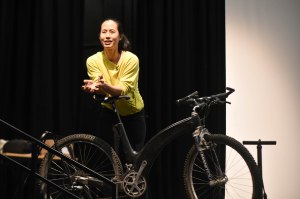 It’s official! Brighton Science Festival was a lot of fun. Andrea Sella, Viki Bloodworth and I had a vast range of props, slides, demonstrations and experiments lined up to explore just a few of the things where science and cycling meet.
It’s official! Brighton Science Festival was a lot of fun. Andrea Sella, Viki Bloodworth and I had a vast range of props, slides, demonstrations and experiments lined up to explore just a few of the things where science and cycling meet.
Viki brought the rare and beautiful Lotus MTB, the monocoque carbon fibre bike designed by Chris Hornzee-Jones of Aerotrope. The finer points of carbon fibre were explored – plus some insights into the extraordinary new developments coming to a man-made composite near you any day soon. 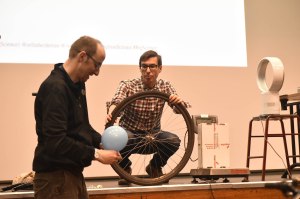 Forty-three years after Eddie Merckx had a special request turned down by Ernesto Colnago, Andrea demonstrated in public, for the first time in recorded history, how the great cyclist could’ve saved 10g from his bike by filling his tyres with hydrogen. It was a gas.
Forty-three years after Eddie Merckx had a special request turned down by Ernesto Colnago, Andrea demonstrated in public, for the first time in recorded history, how the great cyclist could’ve saved 10g from his bike by filling his tyres with hydrogen. It was a gas.
Thanks to EasyComposites, which kindly donated materials, the audience was able to visualise how much bloomin’ air a cyclist has to push aside just to pedal down the road. The instant scale model wind tunnel, powered by Dyson, made apparent the vortex that hides behind every saddle and saps our energies just a little.
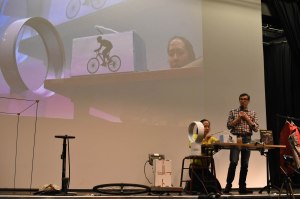 Some of this, and more, will be happening again next month. At the Edinburgh International Science Festival, at 5.30pm on Sunday 12 April, Andrea and I will be joined by Ashleigh Fraser, Scottish National Junior Women’s Road Race Champion. She’ll put us amateurs in our places as she reveals the true science of being best on a bike.
Some of this, and more, will be happening again next month. At the Edinburgh International Science Festival, at 5.30pm on Sunday 12 April, Andrea and I will be joined by Ashleigh Fraser, Scottish National Junior Women’s Road Race Champion. She’ll put us amateurs in our places as she reveals the true science of being best on a bike.
In Chester, at the University’s Thornton campus on Friday 24th April, I’ll be talking and running a couple of cycling science rides for school students. On Saturday 25th April, in the afternoon,
I’ll lead a public cycling science ride in the centre of Chester, complete with demos and experiments. In the evening I’ll be explaining How to Cycle over the Greater Himalayas by Accident. On purpose. 
Photos: Martin J Burton Photography
I’m involved with cycling science events during Brighton Science Festival so I hope you can come along to at least one of them.
First, there’s Cycling Science: The Ride! They are led rides through Brighton, stopping to do experiments and demonstrations. Tickets are on sale here.
You will be the guinea pigs in the experiments and demonstrations and, no matter how much you think you know about cycling or about science, I hope you’ll find out something new.
The rides are family-friendly but tickets are limited so I’ll be doing it at 11.00am on Sunday 1st March and again at 2.30pm on Sunday 1st March.
The rides are supported by Rule 5 Bikes, University of Sussex, Martin Burton Photography, Nick Sayers and the Velo Café.
The other event is a presentation all about the science of cycling which I’ll be giving with Professor Andrea Sella of University College London, BBC TV, Radio 4 and Hackney CC.
He’s the 2015 recipient of the Michael Faraday Prize, given annually by the Royal Society for excellence in communicating science. Yes, he’s terrific.
We’ll be joined by Viki Bloodworth, structural engineer, cycling addict and expert in carbon fibre at Aerotrope. She’ll talk about possible futures for carbon fibre bicycles. And she’ll be bringing an extraordinarily rare and special bike. Viki’s terrific, too.
The presentation is part of Big Science Saturday, on 28th February 2015, and it’s the first event of the day, scheduled to start at 10am. Tickets are on sale here.

 For the time being, my cycling and science stories are not appearing on this blog – because they are being published by Cycling Weekly.
For the time being, my cycling and science stories are not appearing on this blog – because they are being published by Cycling Weekly.
As a self-employed journalist, this makes good sense. It means I can earn part of my living by sharing the wide range of new information that continues to pass across my desk.
You can read my more recent contributions to Cycling Weekly here and the earliest ones here.
Enjoy them and send me your comments.
I’m hoping that other publications, too, will soon be carrying my cycling and science stories – they’ll be different in subject, content and style.
When there’s news about them, it’ll be posted here.
Sorry to be annoying but there are a few things I can’t tell you in this post – such as who, where and when. And I can’t show you any pictures. But I can tell you what.
Last week, having done a respectable few road miles including a surprising 20% climb, I caught the train.
Opposite me was a guy who looked about the same age and he had a well-appointed 29er. He told me where he’d ridden from that day and I suggested it was about 80 miles away.
He looked blank and said he hadn’t done the sums but yes, it had been off-road all the way. He was training.
He was a little disappointed with his training ride because he’d been trying to keep his average speed down to 7.3 mph but hadn’t got it below 7.8 mph.
Most of us train to cycle faster so what kind of training, I asked, involves trying to keep your average speed down?
Long distance, he said.
How long is long distance? I asked.
400 miles, he said.
Off road, he said.
Non-stop, he mumbled.
Right, I said.
“Are you insane?” I thought, but didn’t utter.
Some time soon he’s going to spend 52 hours pedalling, while eating, drinking and sleeping, his way across 400 miles of rough tracks, up thousands of feet of ascents and down thousands of feet of descents. He’s going to do it because it’s not been done before and he likes a challenge. He might not succeed.
Either way, at some point soon, I’ll be able to tell you more, about who he is, where he was riding, when and how he got along.
Until then, I’m going to respect his modesty and his own, mistaken, belief that nobody would be interested in him.
But please, even though you don’t know much at all about his inhuman escapade, do wish him luck. That’s the least he deserves.
It’s been a tough few weeks, trying to ride as much as possible in between work. It was made tougher by the appearance of a ‘fat old man’ on the track each morning, arriving earlier than me and leaving later. It got tougher still when I learned that he’s not fat and he’s younger than me.
Then he had the nerve on Monday to sit on my wheel for 20 minutes while I pushed the air aside as fast as I could. Afterwards, as I ‘warmed down’, he slid past and thanked me for providing shelter from the wind. Polite, yes, but somewhat galling. I could’ve done with some aerodynamic help myself, I thought.
The next day I got a copy of new research into just how beneficial wheelsucking can be. It contained the most dramatic figures I’ve yet seen. OK, they were obtained from experiments with dummies in a wind tunnel and shouldn’t be confused with the real world, but they blew me away.
Under ideal conditions, say the Australian researchers, a rider tucked in behind a leader can reduce their drag by 49%. That’s huge. I’m not saying we were in the ideal conditions on Monday morning but it did, then, seem even more unfair if the ‘thin young man’ might have almost halved his drag by tucking in behind me.
Mind you, the same research confirmed that by riding close to my rear wheel, he would also have smoothed my wake, reducing my own drag by a useful 5%. So maybe that’s why I did achieve my fastest average speed yet this year.
The scientists did some neat research into what happens to the aerodynamics when two cyclists are riding bit and bit, taking turns at the front. You know that feeling you get when a truck overtakes, of being shoved backwards by an invisible maw? Well, the same happens when a rider comes out of the slipstream and draws level with their mate. The drag on both riders increases.
Not that I’m going to tell any of this to the ‘thin young man’. Why should I help him any more? It’s about time he took his turn at the front.
For more info, see The effect of spatial position on the aerodynamic interactions between cyclists by Nathan Barry, John Sheridan, David Burton and Nicholas A.T. Brown
 Normally these posts focus on the work of others and I’m usually spoilt for choice because, on average, I come across one new research paper about cycling and science every single day of the year. And that’s in the English language, only. You can see them all by following @cyclingscience1 on Twitter.
Normally these posts focus on the work of others and I’m usually spoilt for choice because, on average, I come across one new research paper about cycling and science every single day of the year. And that’s in the English language, only. You can see them all by following @cyclingscience1 on Twitter.
So today I’ve been struggling to decide whether to describe a new way of detecting when pro cyclists are lying dopers, or the treatment of vulval swelling among long-distance female cyclists (perhaps as a partner piece to the post about the “third testicle“) or how engineers view the benefits of cycle helmets.
Then it struck me that I should write about the Science of Cycling – a live presentation that’s part of The Times Cheltenham Science Festival, on Sunday 8th June 2014, from 4.30pm.
I got involved in October 2013 when I saw tweets that heaped embarrassingly high praise on my book, from someone called Andrea who claimed also to have “a cunning plan”. Falling into Andrea’s trap, I responded. And I’m glad I did. Andrea turned out to be Andrea Sella, professor of chemistry at University College London and an avid cyclist with Hackney CC.
Through the magic of Twitter, emails, text messages and very occasional phone conversations, the outline of a new kind of event took shape. Andrea’s love of eye-opening, mind-expanding demonstrations were designed to complement information and facts from my book.
Over the months, I’ve blagged equipment and material from the cycling industry while Andrea has accrued weird and wonderful things from the outer reaches of science.
But one thing was still missing – an expert practitioner.
Fortunately, the solution was found at Bespoked – the Handbuilt Bicycle Show at the Olympic Velodrome last month. There was Ted James – leading edge framebuilder and ultra-skilled BMX rider. We were thrilled when he agreed to take part in the Science of Cycling presentation.
Yesterday, the three of us came together for the first time. We put our heads together on the full contents for the hour-long show and, with all the demonstrations, explanations, live action cycling, clear explanations, big-screen graphics and exclusive video clips it came to a little under 5 hours 45 minutes.
So, we have a few days to trim it and use only the very best bits which will reveal unusual and unexpected aspects of cycling and science to all those people who are lucky enough to have booked tickets.
Hope you can make it and don’t be scared to ask questions because our aim is to provoke and stimulate.
See you there.
Cycling is environmentally cool, right? Cyclists are not merely friends of the Earth but lovers, carers and life-long best mates, right? Bicycles are as benign as a gentle breeze wafting a summer meadow, right? Wrong. A new report says otherwise. It lays bare the impact that manufacturing bikes has on the environment. It’s not pretty.
 Just in case you suspect that it’s propaganda put out by the roads lobby or auto industry, you should know that it’s actually been produced at the expense of, and with huge help from, the third largest US bike seller, Specialized. With their income from 9% of the US bicycle market, they’ve paid three post-graduates at Nicholas School of Environment, Duke University, to dig the dirt on how much of our planet’s resources are used and abused to make the machines we love.
Just in case you suspect that it’s propaganda put out by the roads lobby or auto industry, you should know that it’s actually been produced at the expense of, and with huge help from, the third largest US bike seller, Specialized. With their income from 9% of the US bicycle market, they’ve paid three post-graduates at Nicholas School of Environment, Duke University, to dig the dirt on how much of our planet’s resources are used and abused to make the machines we love.
It’s a big report. There’s a massive amount of detail. It deserves to be studied and the facts and figures broadcast, published and gossipped. Such as the fact that it takes more than 30,000 litres of water to make just one Roubaix fork. Specialized uses enough water making Roubaix frames to supply the water needed by 477,000 people per year. “These numbers are staggering”, say the authors.
Making a a kilogram of a carbon frame uses 45% more water than an aluminium frame but, getting its own back in the race to deplete the planet, aluminium frames require more energy during their manufacture. “Over 58.7 gigawatt-hours are used per year to produce all the Allez framesets sold in a year, which is enough power to supply New York City for approximately 128 hours. The Allez frame’s most energy intensive process is artificially aging the aluminum frame to achieve specific metallurgy properties. This requires the frame to be heat treated at 400°F for ten hours.”
the planet, aluminium frames require more energy during their manufacture. “Over 58.7 gigawatt-hours are used per year to produce all the Allez framesets sold in a year, which is enough power to supply New York City for approximately 128 hours. The Allez frame’s most energy intensive process is artificially aging the aluminum frame to achieve specific metallurgy properties. This requires the frame to be heat treated at 400°F for ten hours.”
Other figures are equally shocking. In making all of the Allez framesets that are sold in a year, 6.4 million kilos of carbon dioxide equivalent are released into the atmosphere. To make the Roubaix frame, 1.01kg of waste are generated. For every kilogram of chain produced, there’s an astonishing 3.69kg of waste.
I won’t go on – you can read, open-mouthed, all 179 pages of the report yourself. Download it here. And do compare it with the impacts of other forms of travel, as detailed in the first chapter of my book, Cycling Science.
Of course, Specialized doesn’t do any of the manufacturing itself. It’s done mostly in China and Taiwan, with some components made in Japan. Each country, and each region within it, has different environmental goals. Some even have to meet national or international standards.
And Specialized must be applauded for being so candid about the impact that the making of their bikes is having on Earth. If ths publication can encourage other manufacturers to be equally transparent then there is hope that they will all work together to reduce their eco-footprint – not to boost cycling’s genuine green credentials but for the sake of the planet.
Why does a moving bicycle stay upright? It seems a simple question but, as yet, nobody has been able to answer it exactly.
Scientists are getting closer but mystery still surrounds the precise way geometry, mass, gravity, velocity and gyroscopic forces combine to keep an articulated two-wheeler coasting along, even when there’s no rider.
Now one expert of bike stability, Professor Andy Ruina of Cornell University in Ithaca, New York, has been discussing a curious finding that adds a little more to our knowledge. Last year he presented it to a quiet meeting in Japan. This month he repeated it in the US. If you weren’t at either, here’s the gist.
First, his students built a tricycle, with one wheel at the front and three at the back.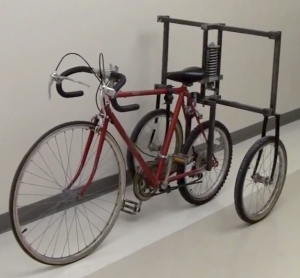
Like most tricycles, the front wheel steers. Unlike most tricycles, there is an adjustable suspension spring for the rear set of wheels.
It’s not a suspension spring to absorb vibration. Instead, it can be adjusted to allow the tricycle’s rear wheels to lean into the corner, in the same way that the rear wheel of a bicycle leans in.
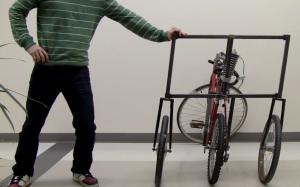 When the suspension spring is given complete flexibility, the rear wheels tilt as the rider leans into the corner, exactly like a bicycle.
When the suspension spring is given complete flexibility, the rear wheels tilt as the rider leans into the corner, exactly like a bicycle.
When the suspension is locked to rigid, the rear wheels are locked upright and the tricycle corners exactly like a tricycle.
That’s why Ruina has nicknamed this hybrid machine as a “bricycle” (not to be confused with the energetic Bricycles cycling pressure group in Brighton UK).
The weirdest thing happens, though, when the suspension is adjusted somewhere in between being being totally flexible and being locked rigid, at a critical point where it counterbalances the forces created for steering.
At this setting, the suspension eliminates the effects of gravity.
It becomes an anti-gravity bricycle.
When the bricyclist tries to corner, by turning the front wheel and/or leaning towards the centre of the curve, the bricycle does not respond. It will not change direction. It just keeps on going straight on.
So, by switching off gravity, it’s impossible to alter course.
What does this clever experiment reveal?
Well, now we know that, as cyclists, without gravity we would be fated to riding forever in one direction. If we wanted to change course we’d have to stop, dismount, pick up our bicycle, turn it and start off again. Our bicycle would be as manoeuverable as a train that’s gone off the rails.
We may curse gravity when we’re riding uphill but, from now on, we should give gravity due praise every time we steer.
*I first stumbled across an abstract of Professor Ruina’s paper and tweeted it in January 2014, later that month he kindly engaged in a Skype conversation. Since then, he and his team have posted an explanatory video of the bricycle in action, with a full explanation of the physics at work. It’s well worth watching – several times!
Is it more effective to train outdoors than in?
In 2003 a woman with Parkinson’s Disease was the stoker on the back of tandem. To keep the pace being set by the male captain, she had to pedal much faster than was easy for her during the ride across Iowa. The happy result was that the symptoms of her degenerative disease were lessened significantly.
Since then, repeated intense exercise has been considered a good way to mitigate the debilitating symptoms of Parkinson’s Disease.
One result is that patients have been encouraged to work out on stationary bikes in gyms. As many cyclists know, this experience just doesn’t compare to riding the open road. It lacks the movement, fresh air and engagement with the real world that is afforded by a real spin.
Now research has shown that intensive cycling hard out on the road could benefit a person with early Parkinson’s Disease more than the same level of exercise on a gym bike.
Why is this?
“If person’s living with Parkinson’s were to be free to ride safely on a recliner bike or tandem bike, the external cues of other people on the bike trail and wildlife may do more for the person and their disease than riding on a stationary bike at home,” says Megan Joanna Avilla, in her Masters thesis, Acute effect of intense exercise on rhythmic gait in persons living with early Parkinson’s Disease.
She may be right. The experience of changing scenery, moving air, seeing people and sensing the environment might enhance the physiological effects of exercise.
If Megan Joanna Avilla’s thesis is correct, does it mean that all outdoor training for any cyclist is more effective than exactly the same exertion on rollers indoors? Do our bodies get fitter by riding through the open air than within four walls?
The implication for all cyclists, including those without Parkinson’s Disease, is that working out could be better than working in.
How much better? Has this been tested? If not, I volunteer (weather permitting).